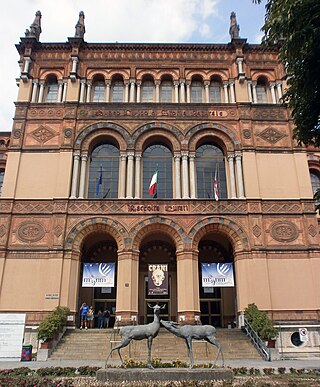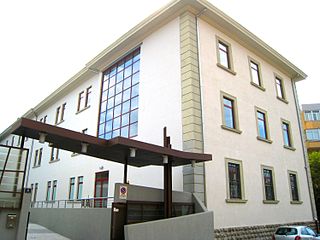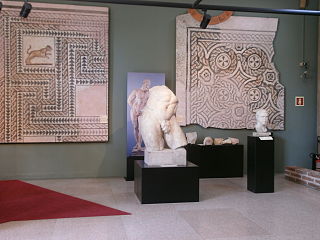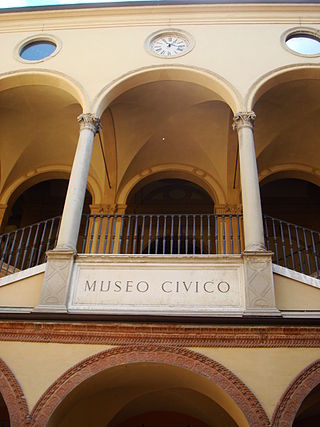 Museo civico aufidenate | |
| Location | Castel di Sangro |
|---|---|
| Type | Archaeology museum |
Museo civico aufidenate (Italian for Civic Museum of Aufidena, an ancient Roman town) is an archaeology museum in Castel di Sangro, Province of L'Aquila (Abruzzo). [1]
 Museo civico aufidenate | |
| Location | Castel di Sangro |
|---|---|
| Type | Archaeology museum |
Museo civico aufidenate (Italian for Civic Museum of Aufidena, an ancient Roman town) is an archaeology museum in Castel di Sangro, Province of L'Aquila (Abruzzo). [1]
The museum was established in 1898, under the name Museo Aufidenate, by the then mayor of Castel di Sangro, Colonel Clemente Marchionna. In 1924, many exhibits were stolen, but the museum remained open and was enriched with new exhibits. The bombing during World War II in 1943-44 forced its closure; there was not much damage to the infrastructure, but the exhibits remained unattended for a long time, followed by numerous lootings. [2]
The collection includes:

The National Archaeological Museum of Naples is an important Italian archaeological museum, particularly for ancient Roman remains. Its collection includes works from Greek, Roman and Renaissance times, and especially Roman artifacts from the nearby Pompeii, Stabiae and Herculaneum sites. From 1816 to 1861, it was known as Real Museo Borbonico.

Castel di Sangro is a city and comune of 6,461 people in the Province of L'Aquila, in Abruzzo, central Italy. It is the main city of the Alto Sangro e Altopiano delle Cinque Miglia area.

The National Roman Museum is a museum, with several branches in separate buildings throughout the city of Rome, Italy. It shows exhibits from the pre- and early history of Rome, with a focus on archaeological findings from the period of Ancient Rome.

Alfedena is a comune in the province of L'Aquila of the Abruzzo region of central Italy. It is located in the Abruzzo, Lazio and Molise National Park in the upper Sangro valley, near the Monti della Meta mountain chain.

The Museo Civico di Storia Naturale di Milano is a museum in Milan, Italy. It was founded in 1838 when naturalist Giuseppe de Cristoforis donated his collections to the city. Its first director was Giorgio Jan.

The Natural History Museum of the University of Pisa, located in the city of Pisa in Tuscany, Italy, is a renowned institution dedicated to the study and display of natural history. The museum is home to one of the largest collections of cetacean skeletons in Europe, showcasing an impressive array of marine mammal specimens. In addition to its extensive cetacean holdings, the museum's oldest collections include seashells amassed by the Italian invertebrate scientist, Niccolò Gualtieri. Serving as both an educational and research institution, the museum invites visitors and scholars to explore the diversity and complexity of the natural world.

Civico Museo di Storia Naturale di Trieste is a natural history museum in Trieste, northern Italy. It contains several collections, including more than two millions botanical, zoological, mineralogical, geological, and paleontological specimens.

Museo Nazionale Scienza e Tecnologia Leonardo da Vinci in Milan, dedicated to painter and scientist Leonardo da Vinci, is the largest science and technology museum in Italy. It was opened on 15 February 1953 and inaugurated by Prime Minister Alcide De Gasperi.

The Museo Nazionale della Magna Grecia, Museo Archeologico Nazionale di Reggio Calabria or Palazzo Piacentini is a museum in Reggio Calabria, southern Italy, housing an archaeological collection from sites in Magna Graecia.

The Museo internazionale e biblioteca della musica is a music museum and music library in the Palazzo Aldini Sanguinetti, in the historic center of Bologna, Italy.

The Archaeological Museum of Milan is located in the ex-convent of the Monastero Maggiore, alongside the ancient church of San Maurizio al Monastero Maggiore, with entrance on Corso Magenta.

The Antonino Salinas Regional Archeological Museum is a museum in Palermo, Italy. It possesses one of the richest collections of Punic and Ancient Greek art in Italy, as well as many items related to the history of Sicily. Formerly the property of the Oratory of Saint Philip Neri, the museum is named after Antonino Salinas, a famous archaeologist and numismatist from Palermo who had served as its director from 1873 until his death in 1914, upon which he left it his major private collection. It is part of the Olivella monumental complex, which includes the Church of Sant'Ignazio all'Olivella and the adjoining Oratory.

The Archaeological Civic Museum of Bologna is located in the fifteenth-century Palazzo Galvani building at Via dell'Archiginnasio 2 postal code 40124 Bologna, once known as the Hospital of Death. Founded in September 1881 by the merging of two separate museums: the one belonging to the University of Bologna – heir of the Room of Antiquity belonging to the Academy of Sciences founded by Luigi Ferdinando Marsili in (1714) – and that belonging to the City of Bologna (enriched by the antique collection of Artist Pelagio Palagi and the large amount of finds from excavations conducted in and around Bologna during these times.

The Museo Storico Nazionale dell'Arte Sanitaria is located within the Ospedale di Santo Spirito in Sassia at 3, Lungotevere in Sassia in Rome (Italy).
Museo Civico may refer to:

Museo archeologico Francesco Savini is an archaeology museum in Teramo, Abruzzo.

Museo civico aufidenate Antonio De Nino is an archaeology museum in Alfedena, Abruzzo.

The National Museum of Ceramics Duca Di Martina is a historical and artistic site situated inside of the Villa Floridiana Park in Naples, Italy. The building used to be one of Campania’s Bourbon royal residences and since 1927 this residence has hosted the museum.

The Civic Museum of Mirandola is a museum housed in the castle of the Pico in Mirandola, in the province of Modena, Italy, dedicated to the archaeology of the territory, religious commissions, ancient furnishings and paintings, coins and medals of the ancient mint of Mirandola. The museum is also enriched by maps from the 16th to the 20th century, various items from the ancient Mount of Piety of the Franciscan friars and a collection of military relics.